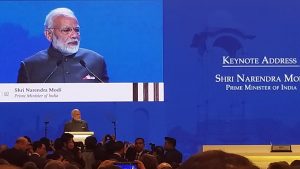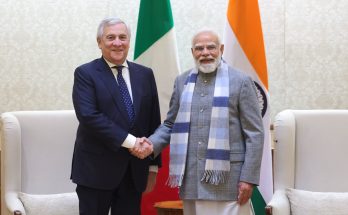
By Sandeep Chakravorty
The Indo-Pacific has become an essential concept in international relations today, in theory as well as in practice. No foreign policy conversation is complete without a discussion on the Indo-Pacific. Literally, it signifies the seamless interface of the Indian and Pacific Oceans. For India, it is that vast maritime space stretching from the western coast of North America to the eastern shores of Africa. Over 50% of global trade traverses this maritime domain. It is also home to over 60% of the world’s population and the global GDP. And so, the security, stability, peace and prosperity of this vast region is vital for the world.
Navigating Indo-Pacific

Whatever the navigation map, it is an indisputable fact that the Indo-Pacific is the 21st century’s locus of political and security concerns and competition, of growth and development, and of technology incubation and innovation. India has not just mainstreamed the expression “Indo-Pacific”, but has also encouraged others to perceive and define the region. That is why European countries such as France, Germany and the Netherlands, physically distant but economic stakeholders in the Indo-Pacific, have released their individual strategies for the region. The UK has constituted the Indo-Pacific Commission which is expected to inform its doctrine. We are aware that at the behest of Portugal, the EU is also working on its strategy for the Indo-Pacific.
India’s Perspective
To understand India’s Indo-Pacific vision it is important to understand why we define it the way we do, and to the extent we do. There are many reasons for this. The first and most obvious is the Indian peninsula, which thrusts into the Indian Ocean and gives us two magnificent coasts and near limitless maritime horizons to both our east and our west. Monks and merchants, culture and cargo have travelled from India on those waters, to our east, west and south. India’s great religious traditions, such as Buddhism, spread far and wide in the Indo-Pacific. Some of the oldest and most impressive Hindu temples are found in Vietnam, remnants of the Cham kingdom. A thousand years ago India’s greatest coastal empire, the Cholas, sent maritime expeditions and trading ships as far east as Sumatra, to ancient China, as well as to the Abbasid empire in what is today Iraq. Another empire, the Pallavas, had a flourishing trade relationship with Southeast Asia. Sea-borne trade with Africa and with the Gulf states have been constants of Indian economic life. These experiences are our past and our future and therefore determine our concept of the Indo-Pacific.
SAGAR Doctrine
India’s Indo-Pacific strategy was enunciated by Prime Minister Narendra Modi in a speech in Singapore in 2018 as the SAGAR doctrine, an acronym for “Security and Growth for All in the Region”. This aspiration depends on securing end-to-end supply chains in the region; no disproportionate dependence on a single country; and ensuring prosperity for all stakeholder nations. An Indo-Pacific guided by norms and governed by rules, with freedom of navigation, open connectivity, and respect for the territorial integrity and sovereignty of all states, is an article of faith for India.
In 2019, at the East Asia Summit in Bangkok, Prime Minister Modi took the idea of SAGAR further and announced the “Indo-Pacific Oceans’ Initiative”. Using this Initiative, India plans to support the building of a rules-based regional architecture resting on seven pillars. These are: 1) maritime security; 2) maritime ecology; 3) maritime resources; 4) capacity building and resource sharing; 5) disaster risk reduction and management; 6) science, technology and academic cooperation & 7) trade connectivity and maritime transport.
India has acted on these principles through both thematic and geographical initiatives. We have sought to strengthen security and freedom of navigation in the Indo-Pacific by becoming a net security provider – for instance in peacekeeping efforts or anti-piracy operations in the Gulf of Aden. Sharing what we can, in terms of equipment, training and exercises, we have forged multi-faceted relationships with partner countries across the region. To cite some examples, we are active in networks such as the Quad, with India, the United States, Japan and Australia as participants, and the India-Japan-US, India-France-Australia and India-Indonesia-Australia trilateral arrangements offer cases in point. It is therefore natural for India to be engaged in cooperation with the key actors in the region and we look forward to engagement by other partners.
Europe’s approach to Indo-Pacific
The Netherlands released its policy paper on the Indo-Pacific in November 2020, which makes it the third EU member state, after France (2019) and Germany (September 2020), to come out with a policy document on the Indo-Pacific. However, as compared to the German and the French doctrines, the Dutch policy is EU-centric and urges the bloc to make strategic and systematic use of its economic influence to better pursue its political interests in the lndo-Pacific region. It has suggested the following elements of a future EU strategy
(i) Strategic Vision of the Indo-Pacific
(ii) Security and Stability
(iii) Working with partners in the Indo-Pacific region
(iv) Sustainable Trade and Economies
(v) Effective multilateralism and international legal order
(vi) Sustainable Connectivity
(vii) Global challenges: climate and the SDGs.
Many elements of the proposed EU approach outlined in the Dutch Guidelines are common to the German and the French approach to the lndo-Pacific and feature in all the three documents with varying degree of focus. These include: rule of law; effective multilateralism; action against climate change; peace and security; connectivity; human Rights; free trade; safe maritime passage and maritime security; and strengthening relations with ASEAN.
The German paper also expands on “culture, education and science” cooperation and the French paper states “Islamist terrorism in the Indo-Pacific” as one of risk for destabilizing the region. The Dutch, factoring in the post-Covid developments, have also highlighted the need to work for reducing one-sided strategic dependencies and sustainably secure value chains. In contrast to the German and French strategy, “Promotion of democratic values” has been included by the Dutch in view of the EU’s stated foreign policy goal of developing and consolidating democracy. The German and the Dutch strategies also support the conclusion of EU’s free trade agreements (FTAC) with India.
On connectivity, all the three countries attach importance to the EU Strategy on Connecting Europe and Asia, with the Dutch also mentioning instituting EU’s connectivity partnerships with ASEAN and India modeled on the EU’s Connectivity Partnership with Japan. Germany and the Netherlands have laid particular emphasis on digital connectivity, with Germany further elaborating the importance of Industries 4.0, AI, and 5G. The German guidelines additionally highlight the security concerns in the digital sphere as well as there are risks of the EU falling into unilateral technological or economic dependencies.
Maritime security, freedom of navigation, UNCLOS and South China sea are also accorded importance in the three strategies. The Dutch suggests that the EU should pursue partnerships to promote maritime security, compliance with UNCLOS.
India figures prominently in all the three documents, with India identified as a democratic like-minded nation and one of the economic priority countries for the EU and member states.
Convergences with India
These policies om the Indo-Pacific are an indication of a strengthening undercurrent within the EU member states for the bloc to adopt its own Indo-Pacific Strategy. A future EU Indo-Pacific approach is likely to feature elements such promotion of democracy, rule of law, human rights, free trade, connectivity, climate change, strengthening EU’s engagement with ASEAN, and effective multilateralism. Nevertheless, an EU approach to the Indo-Pacific is likely to retain the cautious posturing towards China, similar to Germany, as the EU looks to re-balance its relationship with China with a greater emphasis on reciprocity and engage it on issue of climate change.
Furthermore, a shift towards greater Strategic Autonomy by the EU (and its Member States) can be gauged from the three European Indo-Pacific approach papers. From an Indian perspective, it is important to continuously engage the EU on the Indo-Pacific so as to build greater convergences with our Vision especially on the concept of inclusivity. It also endeavours to engage with the EU and Portugal on the seven pillars of India’s Indo-Pacific Oceans’ Initiative (IPOI) as it provides a more comprehensive and inclusive perspective of engaging with the Indo-Pacific region.

(Sandeep Chakravorty is Joint Secretary (Europe West) in India’s Ministry of External Affairs. This article is based on remarks made by him at the first Bilateral Dialogue organized between MP-IDSA and Instituto do Oriente, Lisbon, on February 18, 2021.)
Author Profile
- India Writes Network (www.indiawrites.org) is an emerging think tank and a media-publishing company focused on international affairs & the India Story. Centre for Global India Insights is the research arm of India Writes Network. To subscribe to India and the World, write to editor@indiawrites.org. A venture of TGII Media Private Limited, a leading media, publishing and consultancy company, IWN has carved a niche for balanced and exhaustive reporting and analysis of international affairs. Eminent personalities, politicians, diplomats, authors, strategy gurus and news-makers have contributed to India Writes Network, as also “India and the World,” a magazine focused on global affairs.
Latest entries
 India and the WorldNovember 26, 2025G20@20: Africa’s Moment – The Once and Future World Order
India and the WorldNovember 26, 2025G20@20: Africa’s Moment – The Once and Future World Order DiplomacyOctober 4, 2025UNGA Resolution 2758 Must Not Be Distorted, One-China Principle Brooks No Challenge
DiplomacyOctober 4, 2025UNGA Resolution 2758 Must Not Be Distorted, One-China Principle Brooks No Challenge India and the WorldJuly 26, 2025MPs, diplomats laud Operation Sindoor, call for national unity to combat Pakistan-sponsored terror
India and the WorldJuly 26, 2025MPs, diplomats laud Operation Sindoor, call for national unity to combat Pakistan-sponsored terror India and the WorldJuly 25, 2025When Fire Ends, Diplomacy Begins
India and the WorldJuly 25, 2025When Fire Ends, Diplomacy Begins







